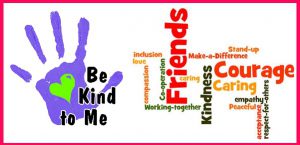Bullying is widespread in the United States and of great concern to many young people, families, educators, youth workers, and community members. According to the Center of Disease Control and Prevention (2012), bullying is a form of youth violence that can cause physical injury, social and emotional distress, and even death.
This issue is very important to local 4-H Agent Abbey Tharpe, who has been working to:
- Promote social and emotional learning and development.

- Address and reduce bullying
- Prevent bullying behaviors by tapping the wisdom and assets of youth and adults.
- Develop positive relationships with peers and adults through 5 weeks of lessons taught to local 6th grade youth for the past 3 years. Each lesson provides hands-on learning activities that allow youth to explore the complexities of the bullying issues in a Safe, Fair, Affirming environment.
- online resources: http://msue.anr.msu.edu/program/info/be_safe
Bullying Prevention
What is Bullying?
Bullying comes in many forms such as social, verbal, physical, and psychological. It can also be an indirect attack causing social isolation through intentional  exclusion. Adding to the problem are perceptions of bullying, often held by students who feel that the victims are at least partially responsible for bringing the bullying on themselves. Some may even believe that bullying toughens a weak person. Parents are often unaware of a bullying problem and consequently do not talk with their children about it. Students often feel that adults/teacher/parents are ineffective and infrequent with their interventions. Therefore, they seldom talk to them about bullying.
exclusion. Adding to the problem are perceptions of bullying, often held by students who feel that the victims are at least partially responsible for bringing the bullying on themselves. Some may even believe that bullying toughens a weak person. Parents are often unaware of a bullying problem and consequently do not talk with their children about it. Students often feel that adults/teacher/parents are ineffective and infrequent with their interventions. Therefore, they seldom talk to them about bullying.
What Can Be Done?
There are many intervention programs that are reframing the way they address bullying. Extension encourages involvement in creating a safe and fear-free learning environment.
 Discuss the definition of bullying and the different forms with everyone in your family, school, and community.
Discuss the definition of bullying and the different forms with everyone in your family, school, and community.- Encourage parents and youth to become more open-minded, tolerant, and accepting so they can see things from other perspectives.
- Encourage children to report bullying, even when they are afraid to do so.
- Build conflict resolution skills to help youth grow, continuously learn, and become better citizens.
- Listen carefully and encourage listening skills of others.
- Brainstorm solutions to the conflict and consider how each alternative solution may prompt a different outcome.
- Discuss the proper use of technology in the home and at school. Sporadically monitor your youths internet and website use.
- Consider involving your pediatrician when physiological and/or psychological symptoms appear.

Taylor Middle School students doing an activity to learn about bullying. - Build supportive home environments that allow your family to discuss problems together to deal with frustration, stress, and anger.
- Stay involved in local schools and activities for youth. Encourage youth to point out positive characteristics of their peers.
Bullying can cause depression, which is not always easily detected. Children who are bullied often become very anti-social and secluded. Even adults can be bullied and should talk to someone if they are or know someone who is being bullied. It is very serious and should be dealt with immediately. Know the signs and symptoms of bullying so that you can help someone in need.
 0
0



Comments are closed.